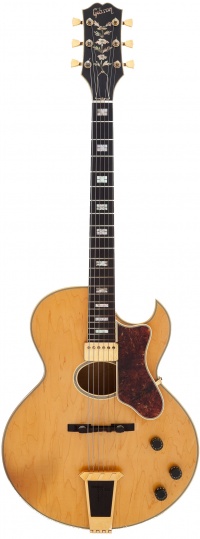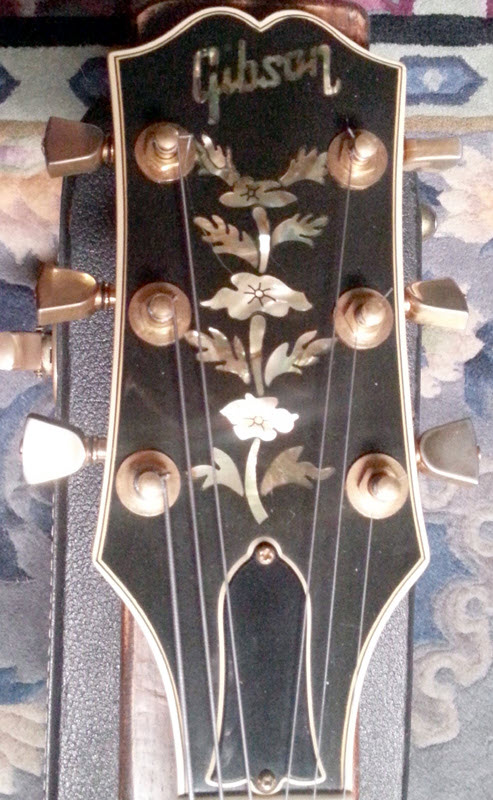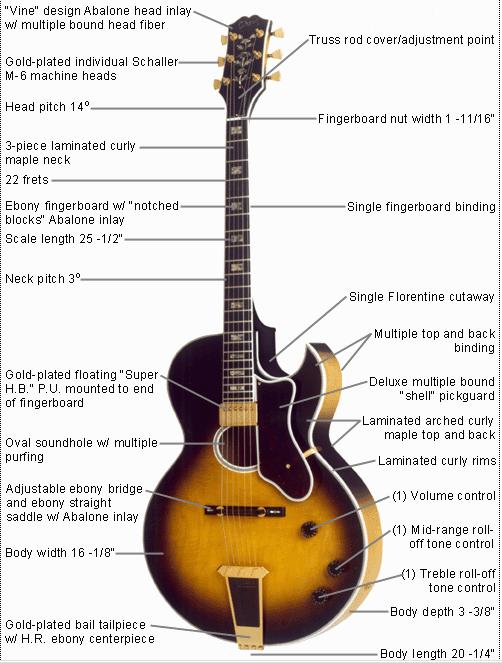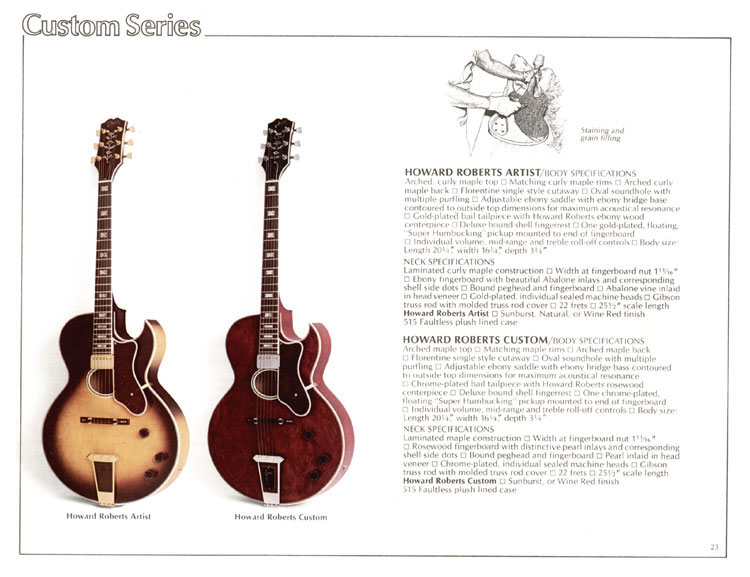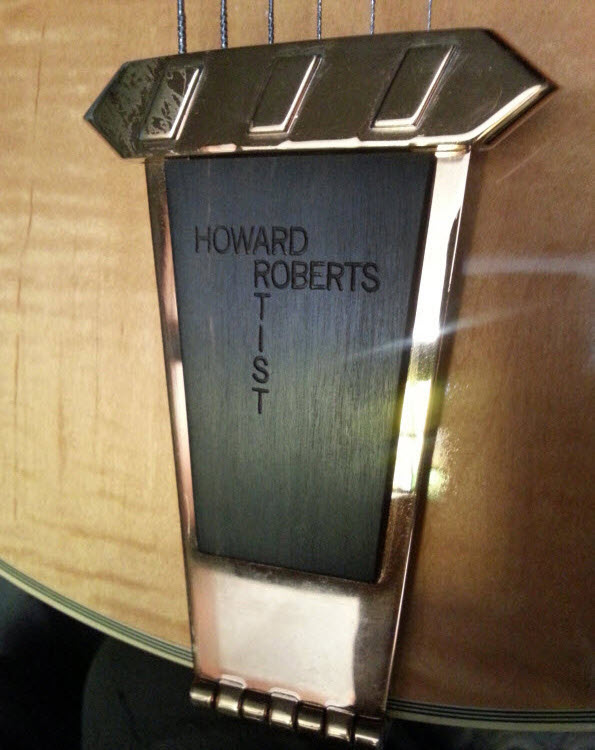Difference between revisions of "Gibson Howard Roberts Artist"
m |
m |
||
| (3 intermediate revisions by the same user not shown) | |||
| Line 2: | Line 2: | ||
<div>__TOC__</div> | <div>__TOC__</div> | ||
<div><h2>Introduction</h2> | <div><h2>Introduction</h2> | ||
| + | |||
| + | |||
[[File:Gibson Howard Roberts Portrait.jpg|200px|right]] | [[File:Gibson Howard Roberts Portrait.jpg|200px|right]] | ||
| + | |||
| + | |||
Gibson’s endorsement with jazz guitarist Howard Roberts began in the mid-1960s with the introduction of the Epiphone Howard Roberts – a unique 16” cutaway model with a pointy Florentine cut-away, oval sound hole, and carved top. A short-lived model, the original Howard Roberts was discontinued in 1969 along with all other USA-made Epiphone models. In 1974 Gibson brought back the Howard Roberts model with some redesign and new branding as the Howard Roberts Custom. The Artist is essentially the same guitar as a Custom, but with upgraded gold hardware, an ebony fingerboard and a different tailpiece name-badge. It features a laminate maple body, multi-ply bindings, slotted block fretboard inlays, and a decidedly Epiphone headstock design, complete with floral / vine inlays. | Gibson’s endorsement with jazz guitarist Howard Roberts began in the mid-1960s with the introduction of the Epiphone Howard Roberts – a unique 16” cutaway model with a pointy Florentine cut-away, oval sound hole, and carved top. A short-lived model, the original Howard Roberts was discontinued in 1969 along with all other USA-made Epiphone models. In 1974 Gibson brought back the Howard Roberts model with some redesign and new branding as the Howard Roberts Custom. The Artist is essentially the same guitar as a Custom, but with upgraded gold hardware, an ebony fingerboard and a different tailpiece name-badge. It features a laminate maple body, multi-ply bindings, slotted block fretboard inlays, and a decidedly Epiphone headstock design, complete with floral / vine inlays. | ||
| − | Low C neck carve with 1-11/16” nut width, 25.4” scale. Figured maple neck, Grover Rotomatic tuners. | + | Low C neck carve with 1-11/16” nut width, 25.4” scale. Figured maple neck, Grover Rotomatic tuners. |
</div> | </div> | ||
</div> | </div> | ||
| − | |||
| − | |||
| − | |||
| − | |||
| − | |||
| − | |||
| − | |||
| + | [[File:Howard Roberts Artist Headstock.jpg|Howard Roberts Artist Headstock.jpg|right]] | ||
| − | + | Gibson manufactured the Howard Roberts Custom between 1973 and 1981. Designed for jazz session guitarist Howard Roberts (who recorded the themes for the Munsters, the Twilight Zone and many other TV classics), this signature model was originally built as an Epiphone in the ’60s. In the ’70s, Gibson made two versions of this guitar, the Custom and the Artist. The two were essentially the same with a distinct oval sound hole, but the Custom featured a Rosewood instead of ebony fingerboard and chrome hardware. | |
| + | Featured on untold thousands of major studio recordings, movie and TV soundtracks as both a sideman and soloist, the late Howard Roberts was almost surely one of the most prolifically recorded jazz guitarists of all time. Like his contemporary Johnny Smith, Roberts also consulted in the creation of a number of technically innovative guitars. | ||
| + | An instrument as versatile as its celebrated creator, the Howard Roberts Model was introduced by Gibson under its Epiphone label in 1965. Made in Kalamazoo, this original guitar combined an arched 16″ Florentine cutaway body with a unique oval soundhole, a design with roots in Orville Gibson’s very earliest guitars. With its long-scale neck, the Howard Roberts also revived the celebrated vine peghead inlay of the prewar Epiphone Deluxe. | ||
| + | The Epiphone Howard Roberts was discontinued by 1968, but revived under the Gibson logo in 1970. A full-sized floating humbucking pickup was produced for this model alone, and unique separate treble and bass tone controls. Three years later, Gibson premiered this version of the model, the Howard Roberts Custom. Produced in limited numbers, the Howard Roberts Custom was offered for less than a decade. | ||
| + | [[File:Howard Roberts Artist Specifications.jpg|right]] | ||
| + | Features – | ||
| + | Body size at lower bout: 16″. Scale length: 25 1/2″ Nut Width: 1 11/16″ | ||
| + | Finish: Wine Red finish, nitrocellulose lacquer | ||
| + | Materials: Seven-ply bound figured maple body; three piece flame maple neck; solid rosewood fingerboard; ornate NY Epi Deluxe style peghead vine inlay, Gibson peghead logo, and split block pearl fingerboard inlays. | ||
| + | Hardware: includes custom trapeze tailpiece; original compensated adjustable ebony bridge with mother of pearl foot inlay; unique full-sized original floating pickup; master volume with separate treble and bass tone controls; original black barrel knobs. | ||
| + | |||
| + | |||
| + | [[File:Gibson Howard Roberts gib78p23.jpg]] | ||
| + | [[File:Howard Roberts Artist body.jpg]] | ||
| + | [[File:Howard Roberts Artist Tailpiece.jpg]] | ||
| + | [[Media:Gibson 1978 Catalog 4.pdf]] | ||
Latest revision as of 07:23, 4 April 2021
Contents
Introduction
Gibson’s endorsement with jazz guitarist Howard Roberts began in the mid-1960s with the introduction of the Epiphone Howard Roberts – a unique 16” cutaway model with a pointy Florentine cut-away, oval sound hole, and carved top. A short-lived model, the original Howard Roberts was discontinued in 1969 along with all other USA-made Epiphone models. In 1974 Gibson brought back the Howard Roberts model with some redesign and new branding as the Howard Roberts Custom. The Artist is essentially the same guitar as a Custom, but with upgraded gold hardware, an ebony fingerboard and a different tailpiece name-badge. It features a laminate maple body, multi-ply bindings, slotted block fretboard inlays, and a decidedly Epiphone headstock design, complete with floral / vine inlays.
Low C neck carve with 1-11/16” nut width, 25.4” scale. Figured maple neck, Grover Rotomatic tuners.
Gibson manufactured the Howard Roberts Custom between 1973 and 1981. Designed for jazz session guitarist Howard Roberts (who recorded the themes for the Munsters, the Twilight Zone and many other TV classics), this signature model was originally built as an Epiphone in the ’60s. In the ’70s, Gibson made two versions of this guitar, the Custom and the Artist. The two were essentially the same with a distinct oval sound hole, but the Custom featured a Rosewood instead of ebony fingerboard and chrome hardware.
Featured on untold thousands of major studio recordings, movie and TV soundtracks as both a sideman and soloist, the late Howard Roberts was almost surely one of the most prolifically recorded jazz guitarists of all time. Like his contemporary Johnny Smith, Roberts also consulted in the creation of a number of technically innovative guitars.
An instrument as versatile as its celebrated creator, the Howard Roberts Model was introduced by Gibson under its Epiphone label in 1965. Made in Kalamazoo, this original guitar combined an arched 16″ Florentine cutaway body with a unique oval soundhole, a design with roots in Orville Gibson’s very earliest guitars. With its long-scale neck, the Howard Roberts also revived the celebrated vine peghead inlay of the prewar Epiphone Deluxe.
The Epiphone Howard Roberts was discontinued by 1968, but revived under the Gibson logo in 1970. A full-sized floating humbucking pickup was produced for this model alone, and unique separate treble and bass tone controls. Three years later, Gibson premiered this version of the model, the Howard Roberts Custom. Produced in limited numbers, the Howard Roberts Custom was offered for less than a decade.
Features –
Body size at lower bout: 16″. Scale length: 25 1/2″ Nut Width: 1 11/16″
Finish: Wine Red finish, nitrocellulose lacquer
Materials: Seven-ply bound figured maple body; three piece flame maple neck; solid rosewood fingerboard; ornate NY Epi Deluxe style peghead vine inlay, Gibson peghead logo, and split block pearl fingerboard inlays.
Hardware: includes custom trapeze tailpiece; original compensated adjustable ebony bridge with mother of pearl foot inlay; unique full-sized original floating pickup; master volume with separate treble and bass tone controls; original black barrel knobs.
Media:Gibson 1978 Catalog 4.pdf
